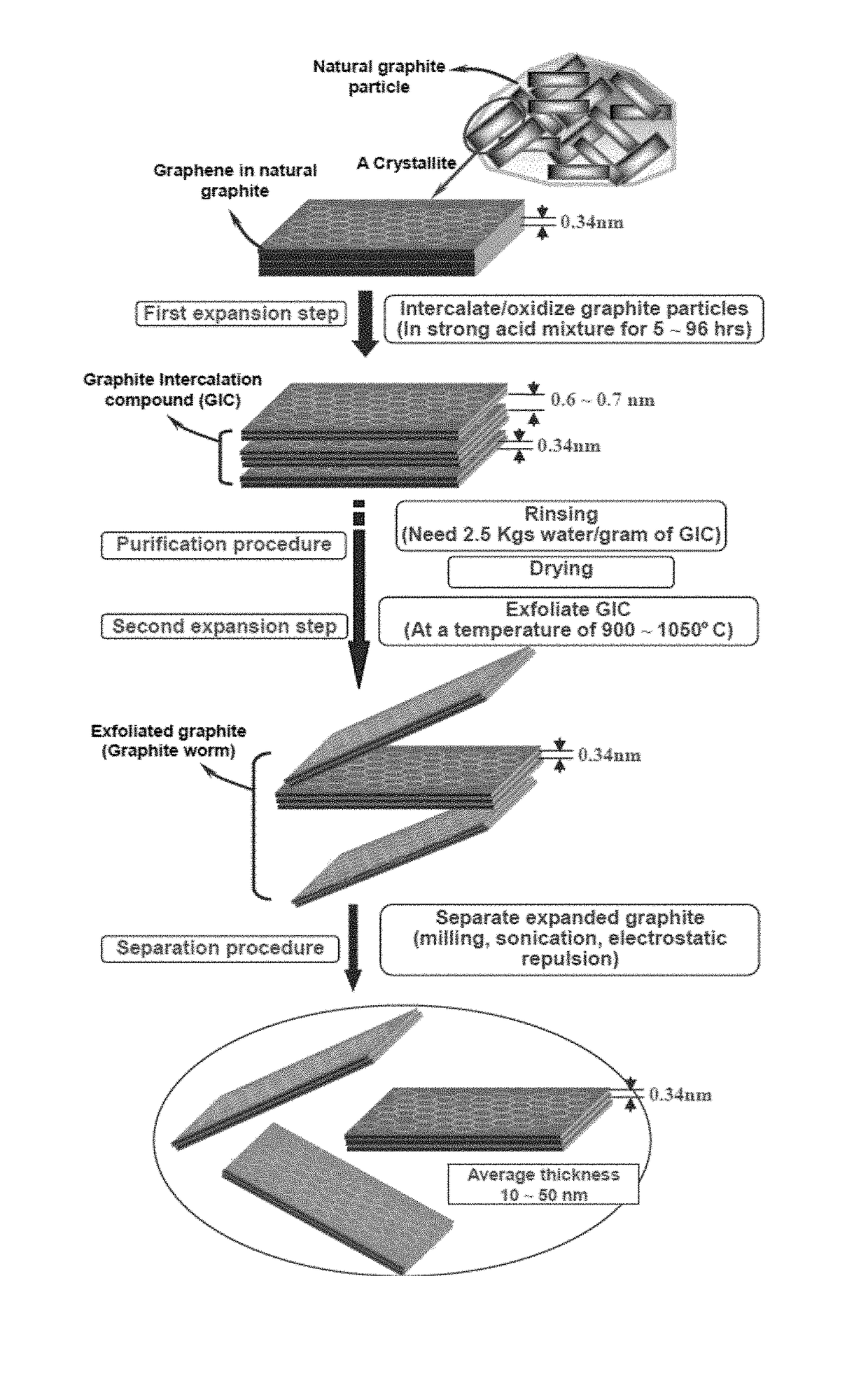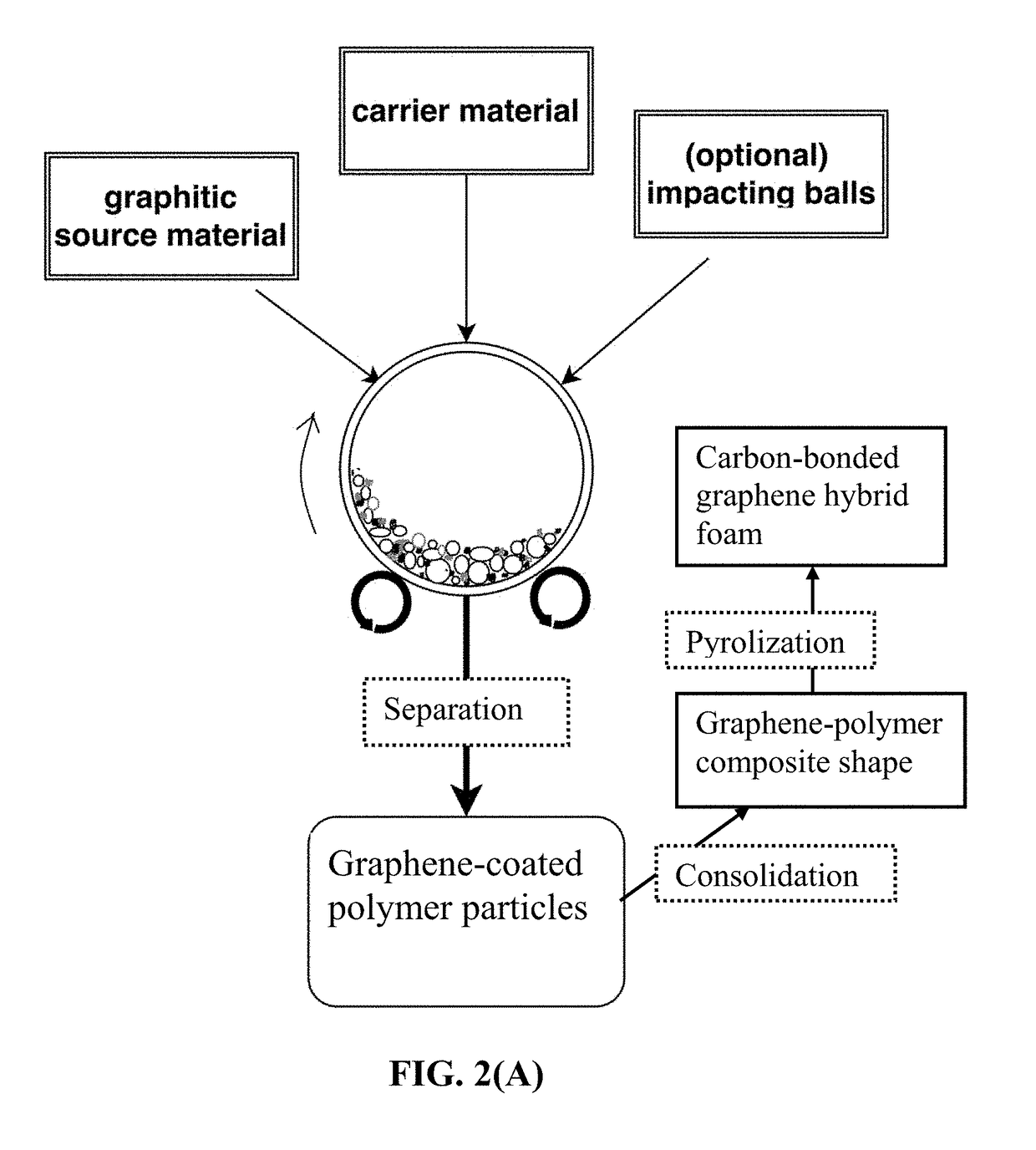Alkali Metal Battery Having an Integral 3D Graphene-Carbon-Metal Hybrid Foam-Based Electrode
a technology of graphene carbon metal and hybrid foam, which is applied in the field of alkali metal secondary batteries having an integral 3d graphene carbon metal hybrid foam electrode, to achieve the effect of long and stable charge-discharge cycle li
- Summary
- Abstract
- Description
- Claims
- Application Information
AI Technical Summary
Benefits of technology
Problems solved by technology
Method used
Image
Examples
example 1
Production of Graphene-Carbon Hybrid Foam from Flake Graphite Via Polypropylene Powder-Based Solid Polymer Carrier Particles
[0155]In an experiment, 1 kg of polypropylene (PP) pellets, 50 grams of flake graphite, 50 mesh (average particle size 0.18 mm; Asbury Carbons, Asbury N.J.) and 250 grams of magnetic stainless steel balls were placed in a high-energy ball mill container. The ball mill was operated at 300 rpm for 2 hours. The container lid was removed and stainless steel balls were removed via a magnet. The polymer carrier material was found to be coated with a dark graphene layer. Carrier material was placed over a 50 mesh sieve and a small amount of unprocessed flake graphite was removed.
[0156]A sample of the coated carrier material was then immersed in tetrachloroethylene at 80° C. for 24 hours to dissolve PP and allow graphene sheets to disperse in the organic solvent for the purpose of determining the nature of graphene sheets produced. After solvent removal, isolated graph...
example 2
Graphene-Carbon Hybrid Foam Using Expanded Graphite (>100 nm in Thickness) as the Graphene Source and Acrylonitrile-Butadiene-Styrene Copolymer (ABS) as the Polymer Solid Carrier Particles
[0163]In an experiment, 100 grams of ABS pellets, as solid carrier material particles, were placed in a 16 oz plastic container along with 5 grams of expanded graphite. This container was placed in an acoustic mixing unit (Resodyn Acoustic mixer) and processed for 30 minutes. After processing, particles of the carrier material were found to be coated with a thin layer of carbon. A small sample of carrier material was placed in acetone and subjected to ultrasound energy to speed dissolution of the ABS. The solution was filtered using an appropriate filter and washed four times with additional acetone. Subsequent to washing, filtrate was dried in a vacuum oven set at 60° C. for 2 hours. This sample was examined by optical microscopy and Raman spectroscopy, and found to be graphene. The remaining pell...
example 3
Production of Graphene-Carbon Hybrid Foam from Meso-Carbon Micro Beads (Mcmbs) as the Graphene Source Material)) and Polyacrylonitrile (PAN) Fibers (as Solid Carrier Particles)
[0164]In one example, 100 grams of PAN fiber segments (2 mm long as the carrier particles), 5 grams of MCMBs (China Steel Chemical Co., Taiwan), and 50 grams of zirconia beads were placed in a vibratory ball mill and processed for 2 hours. After the process was completed, the vibratory mill was then opened and the carrier material was found to be coated with a dark coating of graphene sheets. The zirconia particles, having distinctly different sizes and colors were manually removed. The graphene-coated PAN fibers were then compacted and melted together to form several composite films. The films were subjected to a heat treatment at 250° C. for 1 hour (in room air), 350° C. for 2 hours, and 1,000° C. for 2 hours (under an argon gas atmosphere) to obtain graphene-carbon foam layers. Half of the carbonized foam l...
PUM
 Login to View More
Login to View More Abstract
Description
Claims
Application Information
 Login to View More
Login to View More - R&D
- Intellectual Property
- Life Sciences
- Materials
- Tech Scout
- Unparalleled Data Quality
- Higher Quality Content
- 60% Fewer Hallucinations
Browse by: Latest US Patents, China's latest patents, Technical Efficacy Thesaurus, Application Domain, Technology Topic, Popular Technical Reports.
© 2025 PatSnap. All rights reserved.Legal|Privacy policy|Modern Slavery Act Transparency Statement|Sitemap|About US| Contact US: help@patsnap.com



